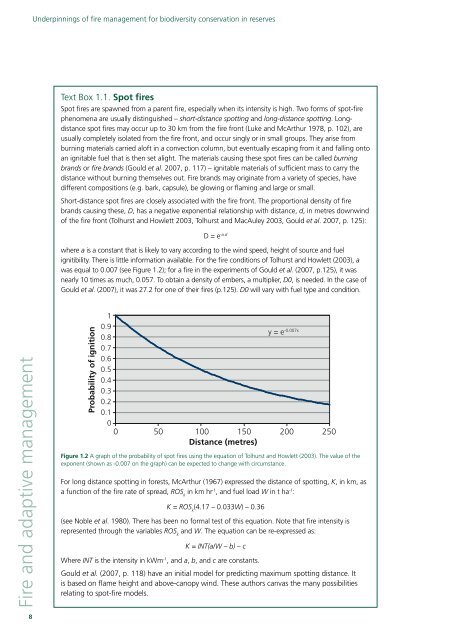Underpinnings of fire management for biodiversity conservation in ...
Underpinnings of fire management for biodiversity conservation in ...
Underpinnings of fire management for biodiversity conservation in ...
You also want an ePaper? Increase the reach of your titles
YUMPU automatically turns print PDFs into web optimized ePapers that Google loves.
<strong>Underp<strong>in</strong>n<strong>in</strong>gs</strong> <strong>of</strong> <strong>fire</strong> <strong>management</strong> <strong>for</strong> <strong>biodiversity</strong> <strong>conservation</strong> <strong>in</strong> reserves<br />
Fire and adaptive <strong>management</strong><br />
Probability <strong>of</strong> ignition<br />
8<br />
Text Box 1.1. Spot <strong>fire</strong>s<br />
Spot <strong>fire</strong>s are spawned from a parent <strong>fire</strong>, especially when its <strong>in</strong>tensity is high. Two <strong>for</strong>ms <strong>of</strong> spot-<strong>fire</strong><br />
phenomena are usually dist<strong>in</strong>guished – short-distance spott<strong>in</strong>g and long-distance spott<strong>in</strong>g. Longdistance<br />
spot <strong>fire</strong>s may occur up to 30 km from the <strong>fire</strong> front (Luke and McArthur 1978, p. 102), are<br />
usually completely isolated from the <strong>fire</strong> front, and occur s<strong>in</strong>gly or <strong>in</strong> small groups. They arise from<br />
burn<strong>in</strong>g materials carried al<strong>of</strong>t <strong>in</strong> a convection column, but eventually escap<strong>in</strong>g from it and fall<strong>in</strong>g onto<br />
an ignitable fuel that is then set alight. The materials caus<strong>in</strong>g these spot <strong>fire</strong>s can be called burn<strong>in</strong>g<br />
brands or <strong>fire</strong> brands (Gould et al. 2007, p. 117) – ignitable materials <strong>of</strong> sufficient mass to carry the<br />
distance without burn<strong>in</strong>g themselves out. Fire brands may orig<strong>in</strong>ate from a variety <strong>of</strong> species, have<br />
different compositions (e.g. bark, capsule), be glow<strong>in</strong>g or flam<strong>in</strong>g and large or small.<br />
Short-distance spot <strong>fire</strong>s are closely associated with the <strong>fire</strong> front. The proportional density <strong>of</strong> <strong>fire</strong><br />
brands caus<strong>in</strong>g these, D, has a negative exponential relationship with distance, d, <strong>in</strong> metres downw<strong>in</strong>d<br />
<strong>of</strong> the <strong>fire</strong> front (Tolhurst and Howlett 2003, Tolhurst and MacAuley 2003, Gould et al. 2007, p. 125):<br />
D = e -a.d<br />
where a is a constant that is likely to vary accord<strong>in</strong>g to the w<strong>in</strong>d speed, height <strong>of</strong> source and fuel<br />
ignitibility. There is little <strong>in</strong><strong>for</strong>mation available. For the <strong>fire</strong> conditions <strong>of</strong> Tolhurst and Howlett (2003), a<br />
was equal to 0.007 (see Figure 1.2); <strong>for</strong> a <strong>fire</strong> <strong>in</strong> the experiments <strong>of</strong> Gould et al. (2007, p.125), it was<br />
nearly 10 times as much, 0.057. To obta<strong>in</strong> a density <strong>of</strong> embers, a multiplier, D0, is needed. In the case <strong>of</strong><br />
Gould et al. (2007), it was 27.2 <strong>for</strong> one <strong>of</strong> their <strong>fire</strong>s (p.125). D0 will vary with fuel type and condition.<br />
1<br />
0.9<br />
0.8<br />
0.7<br />
0.6<br />
0.5<br />
0.4<br />
0.3<br />
0.2<br />
0.1<br />
0<br />
0 50 100 150 200 250<br />
Distance (metres)<br />
Figure 1.2 A graph <strong>of</strong> the probability <strong>of</strong> spot <strong>fire</strong>s us<strong>in</strong>g the equation <strong>of</strong> Tolhurst and Howlett (2003). The value <strong>of</strong> the<br />
exponent (shown as -0.007 on the graph) can be expected to change with circumstance.<br />
For long distance spott<strong>in</strong>g <strong>in</strong> <strong>for</strong>ests, McArthur (1967) expressed the distance <strong>of</strong> spott<strong>in</strong>g, K, <strong>in</strong> km, as<br />
a function <strong>of</strong> the <strong>fire</strong> rate <strong>of</strong> spread, ROS k <strong>in</strong> km hr -1 , and fuel load W <strong>in</strong> t ha -1 :<br />
K = ROS k (4.17 – 0.033W) – 0.36<br />
(see Noble et al. 1980). There has been no <strong>for</strong>mal test <strong>of</strong> this equation. Note that <strong>fire</strong> <strong>in</strong>tensity is<br />
represented through the variables ROS k and W. The equation can be re-expressed as:<br />
K = INT(a/W – b) – c<br />
Where INT is the <strong>in</strong>tensity <strong>in</strong> kWm -1 , and a, b, and c are constants.<br />
y = e -0.007x<br />
Gould et al. (2007, p. 118) have an <strong>in</strong>itial model <strong>for</strong> predict<strong>in</strong>g maximum spott<strong>in</strong>g distance. It<br />
is based on flame height and above-canopy w<strong>in</strong>d. These authors canvas the many possibilities<br />
relat<strong>in</strong>g to spot-<strong>fire</strong> models.





![Metcalfe State Forest Fauna Species List [PDF File - 16.9 KB]](https://img.yumpu.com/22024301/1/184x260/metcalfe-state-forest-fauna-species-list-pdf-file-169-kb.jpg?quality=85)






![PPE Price List for Wildlife Volunteers [PDF File - 20.3 KB]](https://img.yumpu.com/15321634/1/190x135/ppe-price-list-for-wildlife-volunteers-pdf-file-203-kb.jpg?quality=85)




